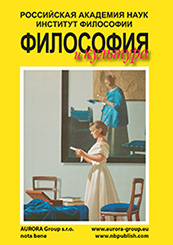Tradition and innovation
Reference:
Wang, D. (2025). Yuan Xuefen’s Yue Opera Creations: Between Tradition and Modernity. Philosophy and Culture, 4, 1–17. https://doi.org/10.7256/2454-0757.2025.4.73640
Read the article
First Peer Review:
Second Peer Review:
Third Peer Review:
|
EDN: TSVVOQ

|
Abstract:
This article analyzes the reforms carried out by the outstanding performer Yuan Xuefen in Chinese Yue opera and her reflections on the ways of developing the genre. From the moment Yuan Xuefen debuted as a leading actress in 1936, she acquired profound mastery in performing traditional Yue opera. She recorded the first gramophone record in the history of this opera with a woman in the leading role — Fang Yuniang Weeps at the Pagoda (《方玉娘哭塔》), which received a wide public response. Beginning in 1942, she turned to the search for ways to modernize traditional Yue opera, creating a series of classic characters, including Xianglin Sao (祥林嫂) in the play of the same name and Jidi (季娣) in the performance Love of Mountains and Rivers (《山河恋》). From the standpoint of the 21st century, in her career, Yuan Xuefen did not blindly adhere to established canons. She carried out innovative reforms in the areas of musical melodies, dramaturgy, and stage expression. The article uses a combination of literature analysis and historical narrative methods. The work is divided into three parts: the first part presents Yuan Xuefen's activities in the history of traditional Yue opera; the second part provides a detailed analysis of the reforms she conducted after 1942 to modernize traditional Yue opera; the third part considers the profound influence of her stage work on contemporary Yue opera art. The novelty of this study lies in the systematic integration of Yuan Xuefen's creative path, through which it was possible to identify specific mechanisms for synthesizing traditional elements of Yue opera with innovative approaches of that time in musical accompaniment, dramaturgy, scenography, and acting skills. The article also presents an integrative theoretical model that combines the traditional aesthetic foundations of Yue opera with Yuan Xuefen's innovative reformist approaches. The model demonstrates how the fusion of cultural heritage and innovative solutions in music, dramaturgy, and stage embodiment ensures the sustainable development of the genre and serves as a methodological basis for further research.
Keywords:
dramaturgy, Chinese aesthetics, theatrical art, reform, modernization, traditional Chinese opera, Yue opera, Yuan Xuefen, stage performance, vocal schools
Philosophy and art
Reference:
Bykova, N.I. (2025). Color antithesis as one of the main semantic concepts of Terrence Malick's film «Days of Heaven». Philosophy and Culture, 4, 18–31. https://doi.org/10.7256/2454-0757.2025.4.74126
Abstract:
The subject of the study is the color scheme, in particular the color antithesis, of Terrence Malick's film «Days of Heaven». The color palette of the film by Terrence Malick, a little-known director at the time of the film's release, caused mixed reviews, both positive and critical. First of all, the work interested the professional jury and viewers with its aesthetic side, so you can still find the opinion that the film «Days of Heaven» is one of the most beautiful in world cinema. The aesthetics of the film, indeed, cannot fail to interest in the originality of the artistic solution. It is important to note that the visual series of the film also performs a conceptually significant task. The object of the study is color as a meaning-forming concept. Color plays a vital role in all spheres of human life, but in the visual arts it often acts as one of the most important components of the artistic solution, on which the basic understanding of the concept and idea of the entire work depends. The main research methods are analytical and comparative-historical. The perception of color and conceptual approaches to the coloristic solution of the film «Days of Heaven», are analyzed. The comparative historical approach is manifested through intertextuality and significant allusions. Terrence Malick's film may be of interest to a modern Russian viewer not only from an aesthetic point of view, but also due to the fact that it raises topical issues of the confrontation between man and nature and touches upon a whole range of social problems that America faced at the beginning of the 20th century. The scientific novelty of the article lies in the study of the main conceptual idea of the film, which follows from the color antithesis, which has practically not been studied by art historians.
Keywords:
antithesis, Days of Heaven, T. Malick, meaning-forming concept, visual-figurative series, pictorial solution, artistic technique, coloristic solution, color symbolism, image of the hero
Philosophy and culture
Reference:
Liu, T. (2025). Ecofeminism in the "Tao Te Ching": Natural Symbolism, Gender Critique, and Cultural Reinterpretation. Philosophy and Culture, 4, 32–44. https://doi.org/10.7256/2454-0757.2025.4.74236
Abstract:
This study explores the philosophical and cultural representation of the feminine principle in Laozi’s Dao De Jing from an interdisciplinary perspective that integrates feminist theory of alterity and ecofeminism. Special attention is paid to the analysis of gendered symbolism—such as the motifs of mother, female, and softness—and their philosophical significance within Daoist thought. The research aims to uncover the hidden mechanisms of symbolic elevation and simultaneous marginalization of the feminine, as well as to examine how such symbolism informs conceptions of subjectivity, nature, and power. The study seeks to interpret feminine imagery not merely as rhetorical devices, but as essential elements of the ontological and ethical model proposed by Laozi. Employing an interdisciplinary methodology, the work combines textual analysis of the Dao De Jing with tools from feminist philosophy, hermeneutics, and comparative cultural studies. The scientific novelty of this research lies in the fact that it presents, for the first time, a comprehensive analysis of the Dao De Jing through the lens of feminist theory of otherness and ecofeminism, focusing on gendered symbolism and the philosophical meaning of the feminine. The study demonstrates that feminine imagery in Daoist thought performs not only metaphorical but also ontological functions, offering an alternative model of power based on fluidity, softness, and the capacity to sustain harmony. At the same time, it reveals an internal contradiction between the symbolic exaltation of the feminine principle and the actual exclusion of women as historical subjects. The conclusion underscores the need for a critical reevaluation of such imagery from an intercultural perspective and highlights its potential for shaping a new ethic of nonviolence, interconnectedness, and equality.
Keywords:
Cultural intertextuality, Maternal Metaphor, Non-dualistic Ontology, Nature and Gender, Patriarchy Critique, Gender Symbolism, Ecofeminism, Taoist thought, Laozi, Dao De Jing
Man and mankind
Reference:
Babich, V.V. (2025). Personal identity: between subjectivity and objectivity. Philosophy and Culture, 4, 45–59. https://doi.org/10.7256/2454-0757.2025.4.72701
Abstract:
The problem of personal identity in contemporary anxiety and debates caused by the influence of the scientific building on human nature is considered. The question is analyzed: can the rapidly accumulating scientific knowledge about the brain and the ability to manipulate biological phenomena of human nature, which affects our sense of self. The presented analysis is based on the findings of Paul Ricoeur's "narrative identity" and the "convergence hypothesis" of the financial inspector. The problem of identity of the result from the position of the external growth of the first and third persons. If the growth of the first person is associated with the qualitative chemical experience of the reflection of human light (phenomenological experience of the "I"), then the growth of the third person involves the use of naturalistic methods for describing the illumination of the "I". Which raises the question of the compatibility of "subjectivity" based on free will and personal experience of self-perception, with the "objectivity" of human light, which is recorded through a naturalistic description of the physical aspect of the "I", which is an impersonal determination of causes and effects within which a person is only a "thing among things". The conclusion is formed that reductionism does not allow to explicate, and thus properly understand, the dynamic, narrative, active, heterogeneous and dialectical (essentially conflictual) nature of personality, which forms the requirements for the construction of a holistic theory of the identity of the "I". It is argued that ensuring the preservation of individual identity provides three continuities: embodied existence, psychological connectedness and cultural continuity. As a "sketch" on the way to the formation of a holistic model of the "I", a representation of individual identity through a dialectical spiral is presented.
Keywords:
reductionism, third person perspective, first person perspective, holism, convergence, narrative identity, personality, phenomenological experience, embodiment, subjectivity
The new paradigm of science
Reference:
Sayapin, V.O. (2025). Ontogenesis of the unfinished and free individual - the ontological project of Gilbert Simondon. Philosophy and Culture, 4, 60–77. https://doi.org/10.7256/2454-0757.2025.4.73032
Abstract:
The subject of this study is the ontological project of the brilliant French philosopher Gilbert Simondon (1924-1989), which consists of examining the individual through individuation in all spheres of reality: physical, biological, psychosocial (transindividual) and even technological. According to Simondon, the point is to use metaphysics to outline the ontological perspective of the individual's development on the path to individuation as a condition for the complete knowledge of reality. In addition, for Simondon, the theory of "individuation" comes from a relational meaning: this concept transforms a certain potentiality into a current reality. That is why this theory consists primarily in the ontogenesis of the individual as a problem of potential fiction: "more than one". The research methodology includes such general scientific approaches as the descriptive method, the categorization method, the method of analysis, observation and synthesis. It should be noted that this article has a search character and is aimed at understanding the individual as unique in relation to himself - unfinished, free and surpassing his being. Moreover, Simondon connects the idea of a free and self-overcoming individual with the concept of technology as a creator-inventor. It follows that technical activity can be considered as an introduction to the true essence and as a manifestation of creative initiative in the name of individual freedom. In conclusion, the author points out: freedom through technology does not mean belonging to a certain gender or being chosen. This is a life calling, since it is based on the readiness to meet the highest risk of death. At the same time, the feeling of freedom inherent in a technician not only imposes great responsibility on him, but also gives his actions a universal ethical value.
Keywords:
hylomorphism, pre-individual reality, transduction, freedom, individuation, individual, technician, being, operation, ontogenesis
Philosophy of language and communication
Reference:
Shliakhtin, N.D. (2025). Analytical philosophy of law in the civil litigation: how to perform actions using words. Philosophy and Culture, 4, 78–94. https://doi.org/10.7256/2454-0757.2025.4.73318
Read the article
First Peer Review:
Second Peer Review:
Third Peer Review:
|
EDN: ATWWNS

|
Abstract:
The subject of the study is the judicial process of the Russian Federation. The author considers the judicial procedure as a communicative model functioning according to the principles of request-response. Within the communicative model, there are certain rules of context, as well as rules for the performance of actions by the parties and their direct representatives. Such actions are carried out by the parties using words that have a certain form and are reflected in the case file. The analysis of speech acts, both written and oral, allowed the author to name individual legal facts according to the classification proposed by G.L.A. Hart. Speech acts used for philological analysis are a ubiquitous form of action in one's own interests or in the interests of the principal in the judicial process. The application of the communicative theory of law made it possible to find a method for changing the dynamics of the judicial process. The methodology of the work is a philological analysis of speech acts used by the parties in the judicial process, as well as a comparison of the result of the speech act with the material trace reflected in the procedural documents of the court case. The result of the work is a confirmation of the predominance of the principle of oral judicial process over the principle of writing, which is expressed in the special position of the audio protocol as a trace of procedural actions using words. The field of application of the research results is the judicial system of the Russian Federation, as a communicative system of requests and responses to conflict resolution. The novelty of the research is expressed in the application of philological and philosophical analysis to the communicative dispute resolution system, which allows us to conclude that the parties directly influence the judge during the trial and change the dynamics of the trial by performing actions using words. The author comes to the conclusion that each of the certain types of speech effects will be an independent legal fact, and the necessary form of their fixation is audio recording of the court session.
Keywords:
illocutionary force, ascriptive concepts, descriptive concepts, procedural legal facts, speech act, philosophy of language, communicative theory of law, analytical philosophy of law, arbitration procedure, Civil procedure
The dialogue of cultures
Reference:
Agratina, E.E. (2025). K.-J. Verne (1714-1789) and the Landscape Painting in the Italian Art Scene. Philosophy and Culture, 4, 95–113. https://doi.org/10.7256/2454-0757.2025.4.74239
Abstract:
Among the representatives of the French artistic community in the second half of the 17th and 18th centuries, it became established tradition to complete one's education with a trip to Italy. The Paris Academy of Painting and Sculpture sent its scholars to Rome, while French patrons could send young painters to the Eternal City at their own expense, which was especially relevant for provincial masters. Such was the case for the Provençal landscape painter Claude-Joseph Vernet (1714–1789). However, he did not limit himself to the traditional educational voyage and spent nineteen years in Italy. The subject of this study is Vernet's work in relation to the characteristics of the development of the landscape genre in the Italian artistic environment. This includes his apprenticeship with masters living in Rome, his impressions from the works of past painters, and the professional environment of contemporary masters. Of course, the international nature of this environment is taken into account: the formation of the landscape genre in Italy was influenced not only by local, but primarily by French and also Flemish masters. The methodology of the research involves a combination of various methods used in art history and a sociological approach relevant to modern science. Although there are some studies in foreign scholarship dedicated to Vernet's time in Italy, they are not comprehensive. In the Russian-language academic space, works on Vernet's art in general are extremely rare, and regarding the Italian period, it remains almost completely overlooked by domestic researchers. This determines the relevance of this article, which is conceived as part of a two-part cycle that thoroughly investigates Vernet's stay and activities in Italy. The presented section examines for the first time in Russian how Vernet's dialogue was built with his predecessors and contemporaries, how professional experience was accumulated both in purely artistic and practical terms through familiarity with past works and personal communication with colleagues. The article reveals how Vernet's creative manner and career developed, as it was in Italy that his genre preferences were fully formed, his specialization in marine landscapes took shape, an individual style was established, and a circle of favored techniques and subjects was developed.
Keywords:
artistic life, artistic connections, educational journeys, art education, marine landscape, landscape painting, painting of the 18th century, painting of the 17th century, art of Italy, exhibition activities
Philosophy and culture
Reference:
Zarutskaya, S.V. (2025). The axiological transformation of Russian culture at the turn of the 19th-20th centuries: convergence and divergence in the Art of the "Silver Age". Philosophy and Culture, 4, 114–131. https://doi.org/10.7256/2454-0757.2025.4.73439
Abstract:
The article examines the role of the art of the "Silver Age" (late 19th – early 20th centuries) in the historical process of axiological transformation of Russian culture. Based on a comparison of the dominant values of the "Golden" and "Silver Ages", as well as an analysis of philosophical and aesthetic theories and specific examples of works of art, the mechanisms of art's influence on public consciousness and value orientations are investigated. The article examines the convergent and divergent processes in the art of the "Silver Age", caused by the crisis of traditional values and the search for new spiritual guidelines. The relevance of the experience of the "Silver Age" is emphasized for understanding the role of art in modern society, in the context of the search for moral guidelines and solutions to global social problems.
Keywords:
integrative style, the field of art, value orientations, public consciousness, cultural field, convergence of values, subjectivity of culture, socio-cultural transformation, Silver age, Axiology
 This work is licensed under a Creative Commons Attribution-NonCommercial 4.0 International License.
This work is licensed under a Creative Commons Attribution-NonCommercial 4.0 International License.
 Eng
Eng












 © 1998 – 2025 Nota Bene. Publishing Technologies. NB-Media Ltd.
© 1998 – 2025 Nota Bene. Publishing Technologies. NB-Media Ltd.




